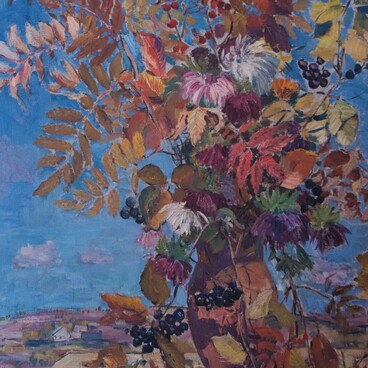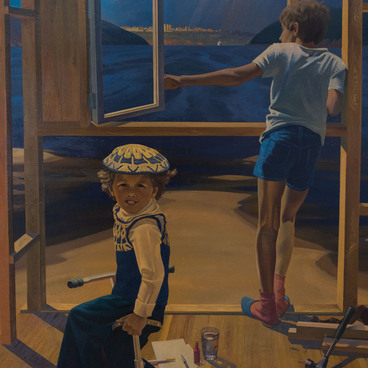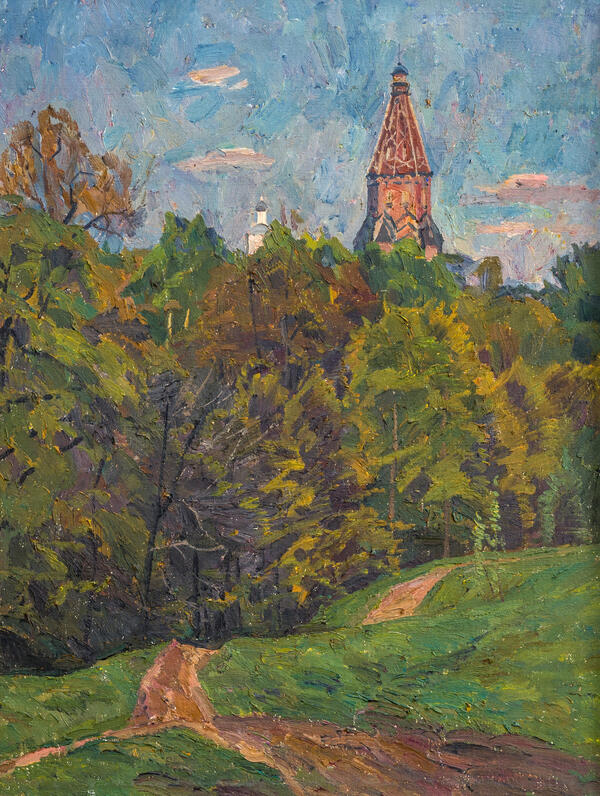The Volzhsky Art Gallery displays the landscape “Lake Sevan” by Armenian artist Albert Papikyan. This is a panorama of a large lake set in a mountain landscape.
Lake Sevan is located on the Armenian Highlands in Armenia. It is the largest lake in the Caucasus. Its area is 1.240 square kilometers. In 1978, the Sevan National Park with four nature reserves and ten zakazniks (a type of protected area) was opened in its vicinity.
Papikyan depicted a narrow strip of shore in the foreground, and two boats on the right. The semicircle of the lake occupies most of the painting. One can see a monastery built many centuries ago on the far shore.
There is a strip of a mountain range in a delicate pinkish hue in the background. The color of the mountains contrasts with the colors that the artist chose for water — a variety of shades from bright turquoise and delicate aquamarine to deep dark blue and purple tones.
Albert Papikyan was born in 1926 in the village of Nalband in the Spitak district of the Armenian SSR. He studied at the Moscow Secondary Art School and at the Repin Leningrad Institute of Painting, Sculpture and Architecture, from which he graduated with honors.
In 1949, Papikyan was accepted as a member of the Artists' Union of the USSR. He participated in many art exhibitions: national, republican, youth, Moscow and foreign.
Albert Papikyan mainly worked in painting. He created genre and thematic paintings, romantic landscapes and still lifes. His work combines the color expressiveness and characteristic decorative elements of the Armenian painting school with rich plastic art and emotional tradition of the Moscow painting school.
One of the main parts of Albert Papikian’s oeuvre was the landscape, for which he selected a special compositional structure. In his work, he always took into account the patterns of spatial relations of the sky, the earth, the uneven outlines of mountains, and large-scale architectural elements inscribed in the landscape. The plots of Papikyan’s paintings were clear. They were characterized by a completeness of composition, color palette and space.
Lake Sevan is located on the Armenian Highlands in Armenia. It is the largest lake in the Caucasus. Its area is 1.240 square kilometers. In 1978, the Sevan National Park with four nature reserves and ten zakazniks (a type of protected area) was opened in its vicinity.
Papikyan depicted a narrow strip of shore in the foreground, and two boats on the right. The semicircle of the lake occupies most of the painting. One can see a monastery built many centuries ago on the far shore.
There is a strip of a mountain range in a delicate pinkish hue in the background. The color of the mountains contrasts with the colors that the artist chose for water — a variety of shades from bright turquoise and delicate aquamarine to deep dark blue and purple tones.
Albert Papikyan was born in 1926 in the village of Nalband in the Spitak district of the Armenian SSR. He studied at the Moscow Secondary Art School and at the Repin Leningrad Institute of Painting, Sculpture and Architecture, from which he graduated with honors.
In 1949, Papikyan was accepted as a member of the Artists' Union of the USSR. He participated in many art exhibitions: national, republican, youth, Moscow and foreign.
Albert Papikyan mainly worked in painting. He created genre and thematic paintings, romantic landscapes and still lifes. His work combines the color expressiveness and characteristic decorative elements of the Armenian painting school with rich plastic art and emotional tradition of the Moscow painting school.
One of the main parts of Albert Papikian’s oeuvre was the landscape, for which he selected a special compositional structure. In his work, he always took into account the patterns of spatial relations of the sky, the earth, the uneven outlines of mountains, and large-scale architectural elements inscribed in the landscape. The plots of Papikyan’s paintings were clear. They were characterized by a completeness of composition, color palette and space.


